Rane FMM 42 Handleiding
Rane
Mengpaneel
FMM 42
Bekijk gratis de handleiding van Rane FMM 42 (4 pagina’s), behorend tot de categorie Mengpaneel. Deze gids werd als nuttig beoordeeld door 6 mensen en kreeg gemiddeld 4.3 sterren uit 3.5 reviews. Heb je een vraag over Rane FMM 42 of wil je andere gebruikers van dit product iets vragen? Stel een vraag
Pagina 1/4

OPERATING / SERVICE MANUAL FMM 42
MASTER MODULE
QUICK START
Operating Manuals! You can’t live with them; you can’t live without them. If you don’t
read them, the damn thing never works right; and if you do read them, you get so confused you
never get it turned on! For you, we present the famous Quick Start section. Read this, and you
get dessert.
If you are using the FMM 42 as a master mixing module, connect the FLEX BUS OUT of
the last mixing module to the FLEX BUS IN on the FMM 42 using the 7-pin DIN patch cable
supplied. Aux bus program is routed through the AUX BUS level controls and then the AUX
BUS LOOP jacks and into the MASTER A/B outputs. Insert your reverb, or any other signal
processing unit, into the BUS LOOPS, by means of the tip=send, ring=return jacks. In addition
to the BUS input, the FMM 42 has a MIC/LINE 1 input and a STEREO LINE 2 input. The
MIC/LINE 1 input is equipped with a Ducking (attenuating) feature, allowing its use as a
priority paging input. This allows voice or other signals to override or attenuate (duck) all other
program routed through the FMM 42. The BUS THRU jack allows routing of the unaltered
Flex bus material to another FMM 42 or other Flex bus equipped module. The FMM 42 may
also be used stand-alone, without any bus inputs, as a straightforward background music/paging
system or the like. In this case the AUX BUS LOOP jacks may be used as additional line inputs
by using special ¼" TRS cables with tip left open, ring as signal hot and sleeve as ground.
NEVER CONNECT ANYTHING EXCEPT AN APPROVED RANE POWER SUPPLY
TO THE RED THING THAT LOOKS LIKE A TELEPHONE JACK ON THE REAR OF
THE FMM 42. This is an AC input and requires special attention if you do not have an
operational power supply EXACTLY like the one that was originally packed with your unit.
See the full explanation of the power supply requirements elsewhere in this manual.
SYSTEM CONNECTION
When connecting the FMM 42 to other components in
your system for the first time, LEAVE THE POWER
SUPPLY FOR LAST. This gives you a chance to make
mistakes and correct them without damage to your fragile
speakers, ears and nerves.
INPUTS. The MIC-LINE 1 INPUT on the FMM 42 is
balanced. This means that standard 3-pin (XLR) connectors
on the ends of any good quality cable work well with the
FMM 42 and a microphone of your choice. In compliance
with American, British and International standards, pin 2 is
used for “hot” or “+” signal polarity, pin 3 is “return” or “–”
and pin 1 is signal ground. For unbalanced inputs, drive pin
2 as hot and pin 1 as ground. It is not necessary to short pin
3 to ground on Flex series microphone inputs; however, it
will not hurt anything, if you do. You may use either pin 1 or
case for shield ground on the 3-pin input. (See Rane Note
110 for further information on this subject). If you are using
the ¼" STEREO LINE 2 input, tip is Channel A, ring is
Channel B and sleeve is ground.
OUTPUTS. The FMM 42’s Master Outputs are bal-
anced. On these outputs, pin 2 is hot (+), pin 3 is return (-)
and pin 1 is signal ground. If unbalanced output is required,
use pin 2 as hot and pin 1 as ground. Do not short any pins to
any others. This is not a transformer balanced output.
BUS INPUTS. The 7-pin DIN
bus connectors are used primarily
with other Flex modules. These are
not MIDI connectors. Use only the
supplied DIN cable. If for some
reason there is not a cable in the
FMM 42 box, please contact Rane
for a replacement. If you are in a
bind, a 5-pin DIN may be used
instead of a 7-pin. The two outside
pins are spares on the FMM 42 and have been included for
possible future compatibility reasons. All pins on the DIN
cable should be wired straight through, i.e., 1 to 1, 2 to 2,
etc.
A typical Flex system using FMM 42s would be where
several FMI 14s are used as input channels, possibly mixed
with a FPM 44 program mixer, all combined with one FMM
42 as the master termination module. In a case like this, the
first FMI 14’s BUS OUT goes to the second’s BUS IN, its
BUS OUT to the third’s BUS IN, and so on down the line.
FPM 44s, FPM 42s, and FLM 82s connect the same way.
The last BUS OUT connects to the FMM 42’s BUS IN. This
sums all input modules properly. See the Flex Users Guide
for additional details.

FRONT PANEL DESCRIPTION
1. MASTER OUTPUT METERS. These LEDs illuminate at the levels indicated.
They track ouput level of each channel only.Calibration: “0dB” LED = Peak equivalent
for +4dBu balanced output level.
2. INPUT 1 OVERLOAD INDICATOR. This red LED illuminates when the input
amplifier approaches a level of 4dB below clipping.
3. INPUT 1 LEVEL CONTROL. This rotary control sets the output level of the Mic/
Line 1 input stage. It is used to set the relative balance between this input and all others
including the Bus inputs.
4. ASSIGN SWITCH. This three position slide switch sends the output of the Input 1
stage to Channel A only, both A & B, or Channel B only.
5. INPUT 1 TRIM CONTROL. This knob is used to set the gain of the input ampli-
fier to accomodate a broad range of microphone sensitivities or line levels.
6. PHANTOM POWER SWITCH. When in the ON position, Phantom Power
(15VDC) is applied to pins 2 and 3 of the 3-pin INPUT connector on the rear panel. This
voltage level is adequate to operate all but the most esoteric microphone types.
7. DUCKER SENSITIVITY CONTROL AND INDICATOR. This rotary screw-
driver control sets the level at which a signal applied to Input 1 causes all other inputs to
be attenuated. The adjacent LED illuminates when this action takes place.
8. DUCKER ON/OFF SWITCH. In the OFF position, you may ignore items 7 and 9
on this page.
9. DUCKER DEPTH CHARGE. This rotary screwdriver adjustment sets the amount
of attenuation imposed on all audio in the module by the priority circuitry described in
great detail elsewhere in this document.
10. LINE 2 A & B INPUT CONTROLS. This concentric rotary control adjusts the
input levels of the LINE 2 INPUT.
11. AUX A AND B BUS LEVEL CONTROLS. These rotary level controls set the
amount of signal going out on the AUX BUS OUTS/LOOPS jacks (tips).
12. DUAL / MIX SWITCH. In the Dual (stereo) mode, Aux A is routed to Master A
only, Aux B mixes with Master B only. In the Mix (mono) position, both Aux inputs sum
with both Master A and B outputs.
13. MASTER A AND B OUTPUT LEVEL CONTROLS. These concentric level
controls set the output levels of Master A and B channels. If rotated individually they
serve the function of both output faders and pan controls.
14. STEREO / MONO SELECTOR SWITCH. In the STEREO mode, Master A and
B outputs are totally independent. In the MONO mode, A and B are summed and identi-
cal.
15. POWER INDICATOR. Indicates power, as indicated.

REAR PANEL DESCRIPTION
1. 3-PIN INPUT CONNECTOR. To be used for either mic or line inputs, pin 2 is hot
“+”, pin 3 is return “–”, and pin 1 is signal ground. Unbalanced inputs should drive pin 2
and use pin 1 as ground.
2. MIC / LINE SELECTOR. In its out position, this switch sets the input stage gain
for microphone usage. When pushed in, the gains are restructured for use with line level
inputs.
3. STEREO LINE 2 INPUT. This is a TRS stereo input. Tip is connected to Channel
A, ring gets connected to Channel B.
4. FLEX BUS INPUT CONNECTOR. When using the FMM 42 with other Flex
mixer modules, the Bus Output of the last module in the system prior to the FMM 42
would be connected to this Input via the 7-pin DIN cable (supplied).
5. FLEX BUS THRU CONNECTOR. To be used in situations where more than one
master module is required. When two or more FMM 42s are required, the second
modules’s Bus Input should be connected to this Output.
NOTE: Special cabling may be constructed which would allow the
bus inputs and outputs to be used for direct inputs and outputs.
See the Flex User’s Guide for additional information.
6. AUX A AND B BUS OUTS/LOOPS CONNECTORS. These ¼" TRS (tip=send,
ring=return) connectors may be used for inserting reverb units or other signal processing
devices (e.g., FPE 13s and FME 15s) in series with the Aux A and B Bus Return Loops.
With Flex units, use a single ¼" TRS cable connecting these inserts to the Patch I/O jacks.
Note: these Loops may be used as additional line inputs when the Flex Bus Inputs are not
used. This requires special ¼" TRS cables with Tip left open, Ring as signal hot and
Sleeve as ground. Additionally, they may serve as AUX outs by using a mono (tip, sleeve)
connector.
7. MASTER A AND B OUTPUTS. These 3-pin balanced outputs use pin 2 as hot,
pin 3 as return and pin 1 as signal ground. For unbalanced operation, pin 2 should be used
as hot and pin 1 as ground. Do not short pin 3 to any other pin. Leave it open.
8. POWER INPUT CONNECTOR. USE ONLY A MODEL RS 1, RAP 10, FRS 8,
OR OTHER REMOTE AC POWER SUPPLY APPROVED BY RANE. The FMM 42 is
supplied with a remote power supply suitable for connection to this input jack. Consult
the factory for replacement or substitution.
9. CHASSIS GROUND POINT. A 6-32 threaded hole used for chassis
grounding purposes. See the CHASSIS GROUNDING note on the last page for
details.
10. GROUND LIFT SWITCH. On this unit, the Ground Lift switch is
located along the bottom edge (vertical mounting), or along the right-hand side
(horizontal mounting). Since the switch’s location may prevent easy use once
installed in the rack, it is suggested you decide which position is required, and
set it before installation. The LIFT position is when the switch is slid to the rear
of the unit.
This switch provides the ability to separate chassis ground and signal ground. Normally, this switch should be in the
LIFT position. In some circumstances it may be necessary to move it to the opposite position to eliminate stubborn hum and
buzz problems. We realize a scientific explanation of this switch would be helpful, unfortunately science doesn’t seem to
have much to do with it. See the CHASSIS GROUNDING note on the last page for details.
If you are tempted to try moving this switch with your power amplifiers turned on or turned up, don't be. Always turn
your amplifier levels down beofre changing your grounds around and then bring them up slowly. Put a speaker re-coner out
of work today!
Product specificaties
| Merk: | Rane |
| Categorie: | Mengpaneel |
| Model: | FMM 42 |
Heb je hulp nodig?
Als je hulp nodig hebt met Rane FMM 42 stel dan hieronder een vraag en andere gebruikers zullen je antwoorden
Handleiding Mengpaneel Rane

18 Juni 2025
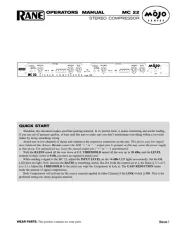
18 Juni 2025
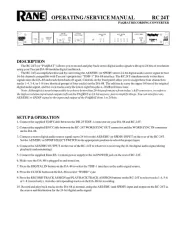
18 Juni 2025
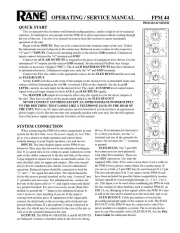
17 Juni 2025
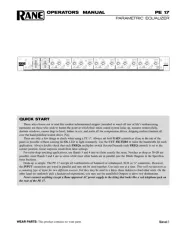
17 Juni 2025
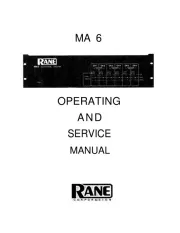
17 Juni 2025
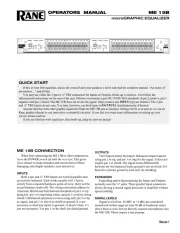
17 Juni 2025
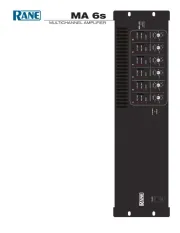
17 Juni 2025
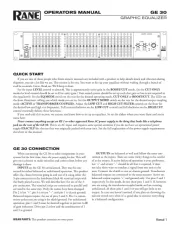
17 Juni 2025
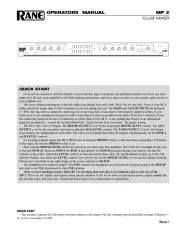
17 Juni 2025
Handleiding Mengpaneel
- Reloop
- Bellari
- Midas
- Crestron
- Bosch
- Black And Decker
- Shakmat
- Kenwood
- Russound
- Fun Generation
- Behringer
- Warm Audio
- Redmond
- Ibiza Sound
- Comfee
Nieuwste handleidingen voor Mengpaneel

8 September 2025

8 September 2025

8 September 2025

8 September 2025

12 Augustus 2025

12 Augustus 2025

11 Augustus 2025

11 Augustus 2025
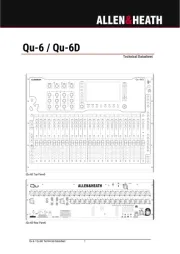
11 Augustus 2025
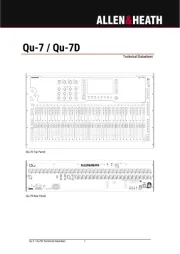
11 Augustus 2025